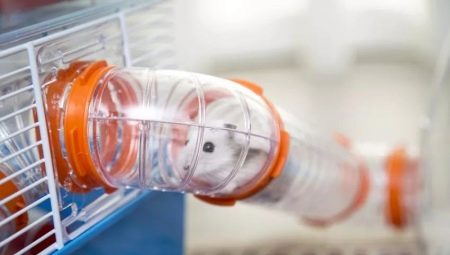Hamsters - small steppe rodents - inhabitants of the branched system of tunnels. Every day they spend many hours in these narrow passages and chambers, even while awake. At the same time, the hamster tries to move as quickly as possible, and this was fixed genetically. Imagining a hamster walking calmly is simply impossible. If he does not stand (or rather, sits), then he must run. And only in the tightness and darkness of the tunnel can he calm down, stop and rest.
Of course, domestic hamsters are deprived of many of the "charms" of wild existence, but for them the tunnels are absolutely necessary. First of all, this is a way to reduce stress caused by the large open space that a hamster has as a room. Along with additional exercise equipment, The tunnel is one of the ways to fight obesity, the most common disease of domestic hamsters. A special function for domestic rodents is performed by artificial labyrinths. It is also an excellent tool that supports research interest, characteristic of many creatures leading a normal lifestyle.
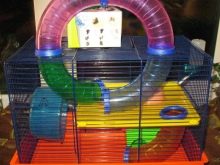
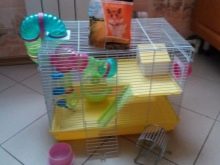
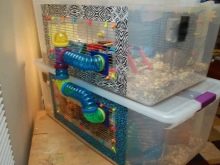
Features and requirements
In nature, hamsters constantly dig, improving and perfecting their holes. Gradually, the tunnels are becoming more tangled and branched. Be sure to build several emergency exits. Digging the ground for a rodent is no less natural process than running or searching for food. In nature, it takes a lot of energy, and hamsters do not need additional exercise equipment to burn the required minimum calories.
In the conditions of home maintenance it is necessary to build artificial labyrinths for hamsters.Natural labyrinths are often located in several tiers, rather long lateral passages, emergency exits, dead-end closets and "bedrooms" depart from them.
The main requirement for artificial holes can be considered the diameter. The rodent, being protected by the tunnel, should feel its walls. At the same time, a too narrow artificial mink will not allow hamsters to disperse. Nevertheless, in nature they live less crowded, and the walls of the holes are earthen and can always be corrected.
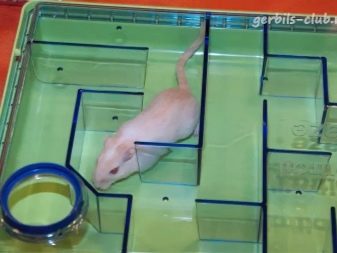


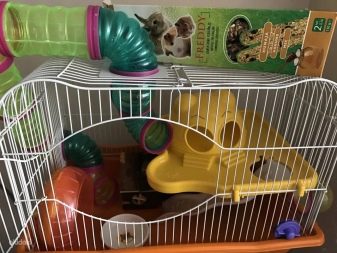
The desire to dig and nibble, as well as the natural desire to constantly improve their tunnels, can move hamsters to a labor feat. They will constantly try the material on the tooth and claw. If the labyrinth is constructed from pliable materials, traces of the work of rodents will be more and more noticeable. To reduce this effect, in tunnels it is necessary to place all kinds of goodies that will have to be chewed.
The material should in no case be toxic, because teeth are the main tool of labor of rodents. They grow constantly, so animals have no problems with their recovery. In earth moving, teeth are used on an equal footing, and sometimes even more, with claws.
When constructing a large artificial hole with several levels of transitions, you must try to avoid too steep descents. Animals can be injured, because unlike burrows dug in the ground, it will be very difficult for them to fix their position with claws. Also, ventilation should be arranged in artificial tunnels so that the pet, carried away by the game, does not die from a lack of oxygen.
It is important not to clutter the cage with the hamster with maze and tunnel designs. He needs space no less. The best option is a remote tunnel or labyrinth, which you can enter from the cage, so that you can return there later.
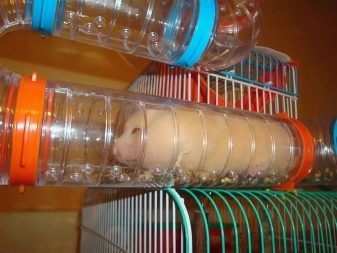
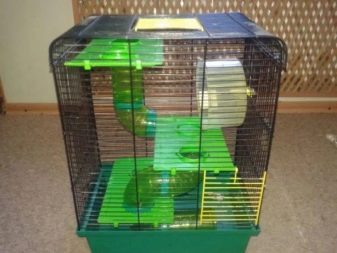

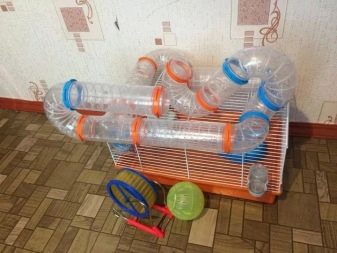
Kinds
The tunnels can have a different shape, length, material of manufacture. May even be transparent. Animals are clearly visible in them. At the same time, they feel protected and do not feel awkward from the presence of observers.
In general, the design of the tunnels is a pipe. Indeed, PVC water pipes can be used to create a system of moves. There can be many options for their articulation.
Specialized pet stores offer several varieties of finished products.
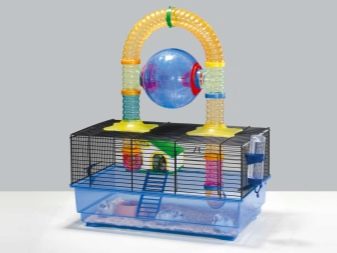
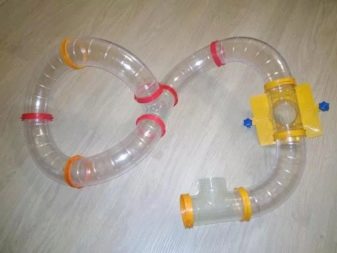
Tunnels come in a simple design - straight lines. Branched designs with a whole system of moves and dead ends are very popular.
The location of the tunnels can be internal, located in the cage where rodents live. The hamster can optionally use the "mink". Sometimes arrange external tunnel, this building, as a rule, has no connection with the cage and is used in cases when the owner decides to arrange entertainment for his pet. The game in such a tunnel is completely controlled by man.
It is possible that the structure of the structure is outside the cage and so that the animal can enter and exit it, falling into the cage where the main nest is arranged.

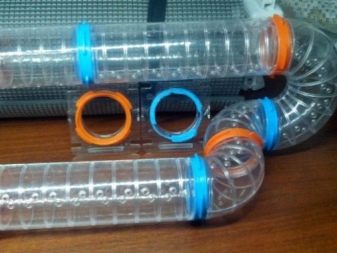
The material used to make the tunnels may be different. Wood is good for this. In addition to performing its basic functions, a “mink” made of wood can also serve as a safe tool for sharpening incisors.
Plastic pipes allow you to vary the structure of the hole. They can be given various forms by various kinds of joints.
There are supporters of nylon "mink". Such a design, when moving the animal, produces a peculiar rustling sound that does not scare the rodent at all, but, on the contrary, attracts it, possibly imitating the sounds made by roots and straws in natural holes.
Special conditions are created by warm plush minks. Playing in such a tunnel, the animal can always rest in comfort.
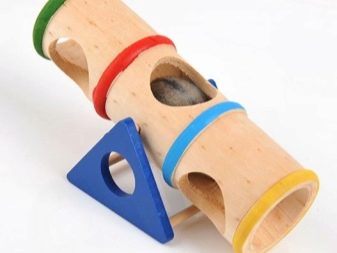
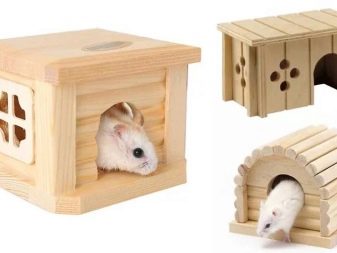
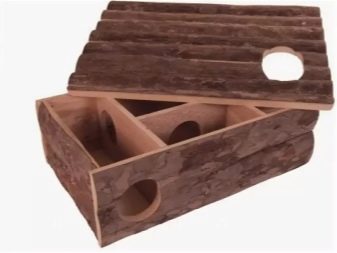
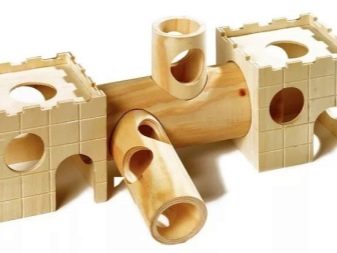
Selection tips
The choice of the finished tunnel is fully determined by the desire of the person. Therefore, one of the conditions of choice should be convenience of observing a pet.
It is important to consider the species features of the hamster, which will use an artificial mink. This will determine primarily the diameter of the artificial hole. Too wide a tunnel may not solve its main tasks. Animals will not feel the protection, being in it, on the contrary, they will be afraid of a large enclosed space.
The best option for artificial holes can be considered those which directly connect to the cage in which the animal is contained.
So the hamster gets rid of the stress associated with its transfer to the labyrinth, and can use it at its discretion.
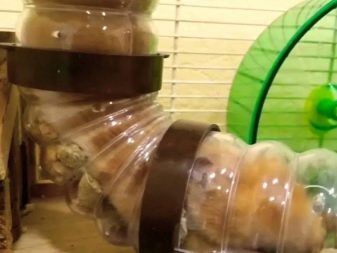
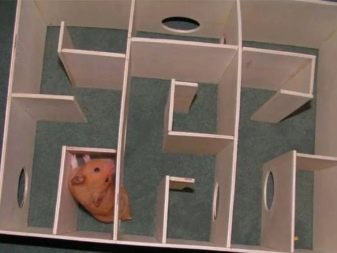
A well-mounted labyrinth with a system of tunnels that are safe and attractive for a hamster is the key to a long and happy life of this animal. The hamster does not just burn calories gained from food, it also loads its small but very inquisitive brain with work. That is why one of the conditions for choosing a structure may be diversity. Tunnels and maze elements can combine different materials, which will give animals additional opportunities for research.
But the basic rule should still be the safety of structures and materials. Strength and quality of joints is also a critical requirement. Researchers will not miss the opportunity to explore your room, if they see it. Often it is the junction of the elements of tunnels or labyrinths that becomes a weak link, and animals that cannot escape from the cage escape through them.
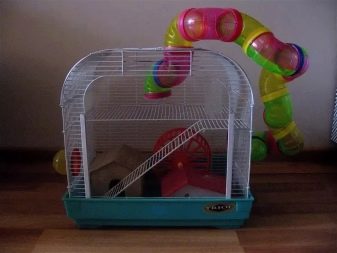
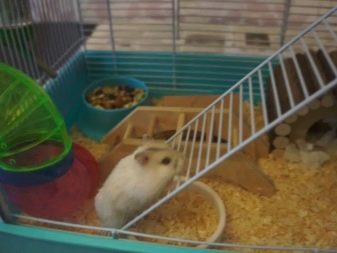
Is it possible to make them yourself?
You can make tunnels and labyrinths yourself. The simplest, one might say, budget option of such a hole is a cardboard construction. Of course, it will not be able to be used constantly, sooner or later, it will have to be updated or replaced at all. Due to the availability of the material, this is actually not critical.
In addition, making a cardboard tunnel with your own hands is a wonderful joint activity for adults and small family members. The limits of children's imagination do not exist, adults only need to adjust their work, discreetly correct and direct them to create a really cozy mink acceptable for pets. Children willingly decorate the building. It is important to ensure that decorations such as rhinestones that are dangerous to rodents are not used, and some adhesives will have to be excluded.
The main advantage of such a makeshift maze is uniqueness. With some experience, you can create plug-in modules that can be replaced or rearranged periodically, this will eliminate addiction, and the pet will constantly examine the proposed structure, which will bring him great pleasure.

The material for creating the labyrinth will be boxes of thick cardboard, for example, from shoes. The set of necessary tools is not so wide: scissors, ruler, pair of compasses, pencil, glue or scotch tape.
The largest box can become the basis of the maze. On its inner surface, you can draw a plan. The side walls will become its walls. Different types of partitions are made from the material of smaller boxes; in them, at different, but accessible to the animal level, passages must be arranged in the form of round holes. Inside separate "rooms" various ladders, cubes, dead-end cameras can be arranged.
Boxes can be combined with tubes, for example, from rolls of toilet paper. Thus, a design with various transitions and cameras can be created in which the pet can spend several hours a day.
The presence of a large number of Lego constructor parts can also become the basis of the maze for the hamster. Children are happy to participate in the creation of such an attraction.

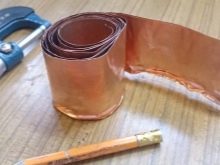
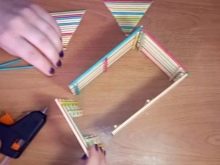
Craftsmen build tunnels and labyrinths even from plastic bottles. However, this material has a significant drawback - it is very slippery. Claws of rodents cannot cling to a plastic surface, so it is better to combine bottles with a cardboard or plywood base.Bottles can be cut in half and fixed on a rougher surface. If a multi-level mink is not intended, the bottles can be reliably connected using tape. One of the indisputable advantages of such a maze is transparency.
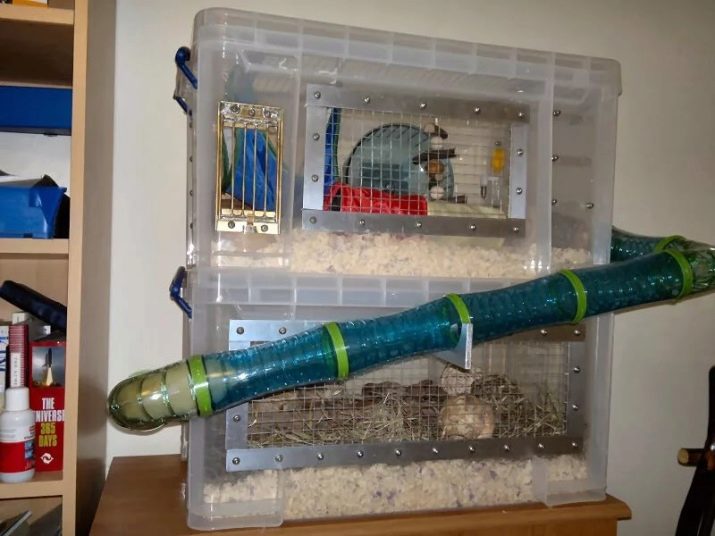
The widest scope of imagination and at the same time the reliability of execution are represented by sanitary pipes made of PVC, a wide variety of connections will allow you to create masterpiece structures. In the walls of such tunnels, it is necessary to make small holes for ventilation. The tightness of their compounds can cause rodent discomfort.

The basic rules for creating artificial labyrinths are quite simple, there are few of them.
- Moderation. Overloading the elements of the maze will quickly tire his researcher, and he will lose interest.
- Security. The use of toxic adhesives is unacceptable. The hamster is sure to try the maze design on the tooth. And also it is advisable to protect it from contact with tape.
- Availability for observation. The animal, being in the maze, should not disappear from the field of view of the owner. All his movements should be observable, and the owner should always imagine where the pet is currently located. Some hamsters are prone to shoots; it can be difficult to get them back; in addition, they are exposed to serious dangers in the process of their “willfulness”.
On how to make a tunnel for a hamster out of plastic bottles, see further.
